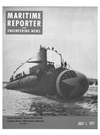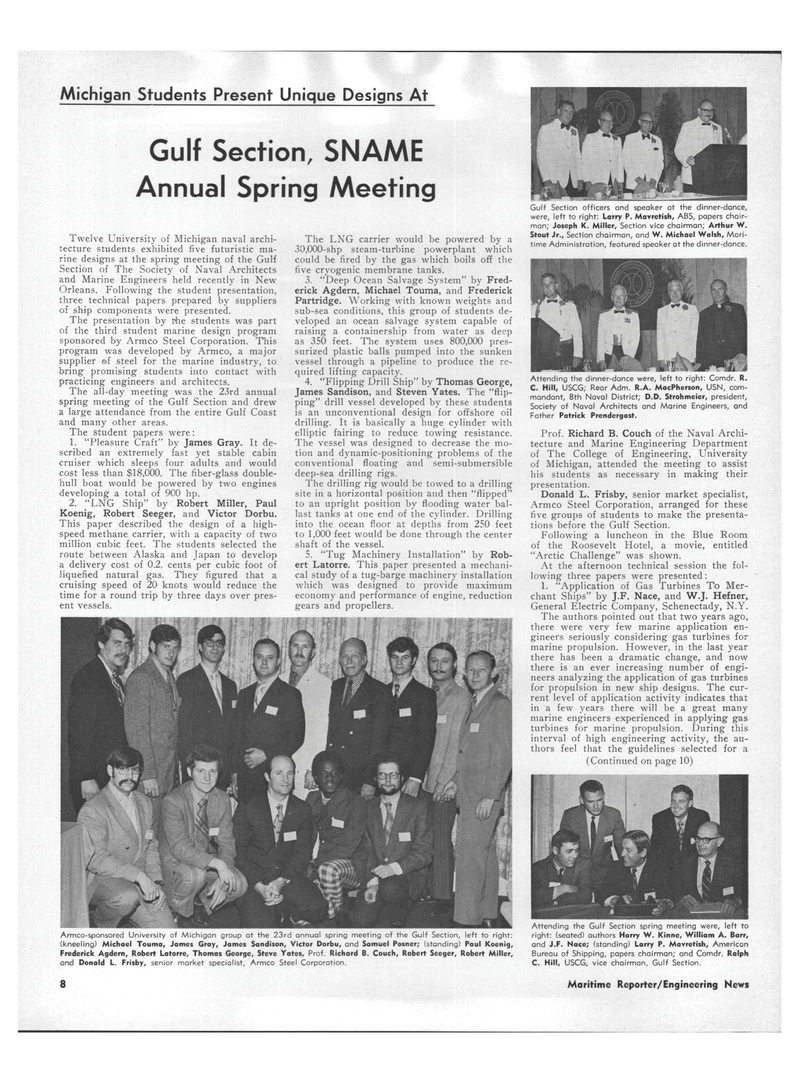
Page 2: of Maritime Reporter Magazine (July 1971)
Read this page in Pdf, Flash or Html5 edition of July 1971 Maritime Reporter Magazine
Michigan Students Present Unique Designs At
Gulf Section, SNAME
Annual Spring Meeting
Twelve University of Michigan naval archi- tecture students exhibited five futuristic ma- rine designs at the spring meeting of the Gulf
Section of The Society of Naval Architects and Marine Engineers held recently in New
Orleans. Following the student presentation, three technical papers prepared by suppliers of ship components were presented.
The presentation by the students was part of the third student marine design program sponsored by Armco Steel Corporation. This program was developed by Armco, a major supplier of steel for the marine industry, to bring promising students into contact with practicing engineers and architects.
The all-day meeting was the 23rd annual spring meeting of the Gulf Section and drew a large attendance from the entire Gulf Coast and many other areas.
The student papers were: 1. "Pleasure Craft" by James Gray. It de- scribed an extremely fast yet stable cabin cruiser which sleeps four adults and would cost less than $18,000. The fiber-glass double- hull boat would be powered by two engines developing a total of 900 hp. 2. "LNG Ship" by Robert Miller, Paul
Koenig, Robert Seeger, and Victor Dorbu.
This paper described the design of a high- speed methane carrier, with a capacity of two million cubic feet. The students selected the route between Alaska and Japan to develop a delivery cost of 0.2. cents per cubic foot of liquefied natural gas. They figured that a cruising speed of 20 knots would reduce the time for a round trip by three days over pres- ent vessels.
The LNG carrier would be powered by a 30,000-shp steam-turbine powerplant which could be fired by the gas which boils off the five cryogenic membrane tanks. 3. "Deep Ocean Salvage System" by Fred- erick Agdern, Michael Touma, and Frederick
Partridge. Working with known weights and sub-sea conditions, this group of students de- veloped an ocean salvage system capable of raising a containership from water as deep as 350 feet. The system uses 800,000 pres- surized plastic balls pumped into the sunken vessel through a pipeline to produce the re- quired lifting capacity. 4. "Flipping Drill Ship" by Thomas George,
James Sandison, and Steven Yates. The "flip- ping" drill vessel developed by these students is an unconventional design for offshore oil drilling. It is basically a huge cylinder with elliptic fairing to reduce towing resistance.
The vessel was designed to decrease the mo- tion and dynamic-positioning problems of the conventional floating and semi-submersible deep-sea drilling rigs.
The drilling rig would be towed to a drilling site in a horizontal position and then "flipped" to an upright position by flooding water bal- last tanks at one end of the cylinder. Drilling into the ocean floor at depths from 250 feet to 1,000 feet would be done through the center shaft of the vessel. 5. "Tug Machinery Installation" by Rob- ert Latorre. This paper presented a mechani- cal study of a tug-barge machinery installation which was designed to provide maximum economy and performance of engine, reduction gears and propellers.
Armco-sponsored University of Michigan group at the 23rd annual spring meeting of the Gulf Section, left to right: (kneeling) Michael Touma, James Gray, James Sandison, Victor Dorbu, and Samuel Posner; (standing) Paul Koenig,
Frederick Agdern, Robert Latorre, Thomas George, Steve Yates, Prof. Richard B. Couch, Robert Seeger, Robert Miller, and Donald L. Frisby, senior market specialist, Armco Steel Corporation.
Gulf Section officers and speaker at the dinner-dance, were, left to right: Larry P. Mavretish, ABS, papers chair- man; Joseph K. Miller, Section vice chairman; Arthur W.
Stout Jr., Section chairman, and W. Michael Walsh, Mari- time Administration, featured speaker at the dinner-dance.
Attending the dinner-dance were, left to right: Comdr. R.
C. Hill, USCG; Rear Adm. R.A. MacPherson, USN, com- mandant, 8th Naval District; D.D. Strohmeier, president.
Society of Naval Architects and Marine Engineers, and
Father Patrick Prendergast.
Prof. Richard B. Couch of the Naval Archi- tecture and Marine Engineering Department of The College of Engineering, University of Michigan, attended the meeting to assist his students as necessary in making their presentation.
Donald L. Frisby, senior market specialist,
Armco Steel Corporation, arranged for these five groups of students to make the presenta- tions before the Gulf Section.
Following a luncheon in the Blue Room of the Roosevelt Hotel, a movie, entitled "Arctic Challenge" was shown.
At the afternoon technical session the fol- lowing three papers were presented: 1. "Application of Gas Turbines To Mer- chant Ships" by J.F. Nace, and W.J. Hefner,
General Electric Company, Schenectady, N.Y.
The authors pointed out that two years ago, there were very few marine application en- gineers seriously considering gas turbines for marine propulsion. However, in the last year there has been a dramatic change, and now there is an ever increasing number of engi- neers analyzing the application of gas turbines for propulsion in new ship designs. The cur- rent level of application activity indicates that in a few years there will be a great many marine engineers experienced in applying gas turbines for marine propulsion. During this interval of high engineering activity, the au- thors feel that the guidelines selected for a (Continued on page 10)
Attending the Gulf Section spring meeting were, left to right: (seated) authors Harry W. Kinne, William A. Barr, and J.F. Nace; (standing) Larry P. Mavretish, American
Bureau of Shipping, papers chairman; and Comdr. Ralph
C. Hill, USCG, vice chairman, Gulf Section. 8 Maritime Reporter/Engineering News

 1
1

 3
3
